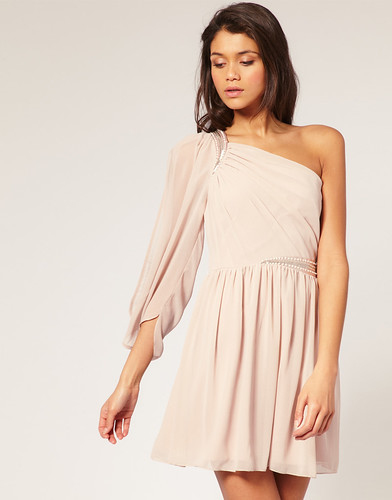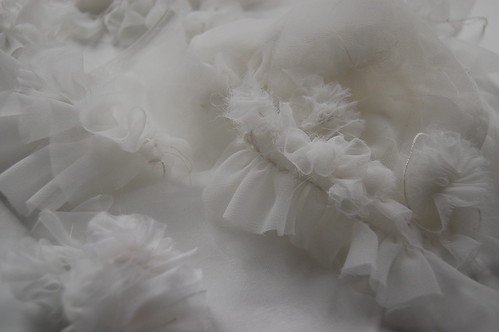Monday, December 3, 2012
Sewing Machine Repair Tips: Brother VX 1100
One of the sewing machine repair and maintenance basics is to clean your machine often so as not to accumulate dirt that can cause problems. In case of a brother sewing machine like Brother VX 1100, the sliding parts of the shuttle race should be cleaned regularly to avoid lint from accumulating.
Thursday, November 29, 2012
How to accessorize a nylon chiffon dress?
Accessorize Nylon Chiffon Dress
Okay then, you bought the dress. However, you haven't decided what bag to go with it, or what pair of shoes to partner your dress. That luxurious and elegant fabric would surely miss its purpose if you did it wrongly. So how to do properly accessorize a nylon chiffon dress? The image of urban elegance and poise should clearly reflect this nylon chiffon dress. Simply get a pair of the classic black pumps and a structured clutch and you are ready to go! If you want to add some embellishments, a golden bangle or a clustered necklace would a modern chic look!Get the Chic Look: Accessorize Nylon Chiffon Dress
How To Accessorize A Chiffon Dress Watch How To Accessorize A Chiffon Dress from the leading how to video provider. This instructional video will give you helpful instructions to make sure you get good at fashion, fashion skirts and dresses.Get into the posh trend of accessorizing nylon chiffon dress
Pressed Flower Nylon Chiffon DressWednesday, November 28, 2012
Sewing machine repair and maintenance
Sewing machines, when cared properly can last for a long time. That is why understanding sewing machine repair and maintenance can save you from hassle and save bucks!
Sewing machine repair and maintenance
Here are some of the basic things you should know about sewing machine repair and maintenance: Take time to browse your user's manual. This will save you from unnecessary hassles and expenses. Most of the time, sewing machine problem only happens because of lack of oil and cleaning.Sewing Machine Repair and Protection and Cleaning
Having your sewing machine covered with a piece of cloth can do a lot. It ensures that the machine is safe from lint, dust and other particles that can enter the machine and cause it to rust. This is especially important for computerized sewing machines. In this type, you are trying to keep the sensitive circuit boards away from physical and weather hazards. Compressed Air Use the user's manual before using compressed cannned air to avoid blowing unnecessary dirt or lint into different areas of the machine's mechanism. If the manual approves this cleaning method, you can use it to clean the small areas your brush can't get into. Replacing Light Bulbs and Broken Needles Make sure you have the bulb's model number and that the sewing machine is switched to the "off" position prior to changing the bulb. Additionally, bent or broken sewing needles must be replaced immediately. You can do this by raising the needle bar to its highest position and loosening up the needle clamp screw, you can slide the needle as far as it can go and tighten the clamp. You can test the new needle by stitching onto a piece of scrap fabric.Tuesday, November 27, 2012
How to make a nylon chiffon hair clip
Nylon chiffon is one of the most versatile fabrics. Although it is lightweight, it can be the most durable fabric you can play with. Here, we will try to make a ruffle hair clip using a nylon chiffon fabric.
Make a nylon chiffon hair clip
We need to prepare the following for the ruffled hair clip made with nylon chiffon.- Alligator clip
- Ruler
- 1/8-yard chiffon
- Scissors
- Sewing machine
- Hot-glue gun
- Scale the length of the clip. Cut a 3-inch-wide, 2-inch-wide and 1-inch-wide strip of chiffon, three times the length of the clip. The extra length will be used for gathering to make the ruffle.
- Lengthen the stitch and loosen the tension of your sewing machine. This is to prepare for sewing a basting stitch. Additionally, it will enable you to move the fabric along the seam.Stack all three strips of chiffon from widest to narrowest. Sew a basting stitch lengthwise down the center of the stack of chiffon strips, leaving tails on each end of the seam at least 6 inches long. The long tails give you enough thread to tie knots and to hold while you gather the fabric.
- After this, knot the threads at one end of the basting stitch seam. While you push the chiffon up the seam toward the knotted end to create a ruffle, hold the threads at the other end of the seam. Keep pushing the fabric up the seam until the chiffon ruffle is the same length as the alligator clip. Knot the thread at the other end of the seam to hold the chiffon gathers. Trim the thread at both ends close to the knots.
- With your ruffle nylon chiffon clip done, place it on the top of an alligator clip using a hot glue. Dry the glue and cool for five minutes.
- Wear and enjoy!
Monday, November 26, 2012
Sewing Nylon Chiffon
 Sewing nylon chiffon and sheers can be difficult when the nylon chiffon is knit rather than woven. Make sure you handle it properly. Here are some tips in sewing knit nylon chiffon fabric.
Sewing nylon chiffon and sheers can be difficult when the nylon chiffon is knit rather than woven. Make sure you handle it properly. Here are some tips in sewing knit nylon chiffon fabric.A Straight Hem
Make sure the cut edge of the hem is even. Use a straight edge or ruler to even the cutting edge of the chiffon draw a straight line on the chiffon. Cut off the excess with a ruler so it will not slip. Look for a ruler that will not slip.
Cutting Nylon Chiffon
Place tissue paper under the fabric. Pin or place weights. Cut through the pattern paper and the fabric. Cut very straight! Cut as a single fabric.
Hemming
Starting the rolled hemmer is the important step to a straight hem. Fold edge of fabric about 1/8" (a distance of only about 2 inches from edge). Finger crease. Lower your foot, having the needle enter near the edge of fabric. Take a couple of stitches. Raise the foot. Pull the back threads with left hand, and wiggle the hem into the hemmer scroll. A little jiggling will get it in properly. You will know it is in the scroll when you can't move the foot backwards any more. Lower the foot and begin sewing, keeping the back threads and fabric a little taunt. It is important to keep the mouth of the hemmer full of fabric for an even hem.
Needle Plate
Use a small hole needle plate so the fabric doesn't get pushed into the hole. If you don't have a small hole, put some tape over the hole. Lower the needle several times (no thread) to make a hole in the tape.
Machine Needles Use universal needles size 60/8 to 70/10.
Friday, November 23, 2012
Removing stains on nylon chiffon fabric
Because chiffon is sheer and lightweight it can be difficult to clean. When removing stains on nylon chiffon fabric, it is important that you make sure that the fabric still looks brand new after the process. Although there is no suitable stain remover for all types of fabrics, you can try the steps below to help you out.
 fabricsnet.blogspot.com
fabricsnet.blogspot.com
11/22/12
Because chiffon is sheer and lightweight it can be difficult to clean. When removing stains on nylon chiffon fabric, it is important that you make sure that the fabric still looks brand new after the process. Although there is no ...
How can I remove a black caviar stain from my chiffon dress?
 www.russiandogs.net
www.russiandogs.net
12/3/07
Question by Sarah S: How can I remove a black caviar stain from my chiffon dress? Dry-cleaning didn't help.? I had a small egg or two on my thumb, wiped it on.
Removing stains on nylon chiffon fabric
Things that you need:- Powder
- Sponge
- White cloth
- Borax
- Vinegar
- Peroxide
How to remove stains on nylon chiffon fabric
- Remove the stains using an absorbent powder. Sprinkle some cornstarch, talc or flour on the stain. Brush away the powder until the stain as been absorbed.
- Using the white cloth, dip it on the vinegar. Dab some vinegar on the stains on the chiffon. Allow the vinegar to sit on the stain. When the vinegar dries, rinse with washing powder and water.
- Lighten ink and dye stains with a mixture of 1 1/2 cups warm water and 1/4 cup hydrogen peroxide. Apply the solution on with a sponge and rinse it away by dabbing it up with a clean, moist sponge.
- Mix 1/4 cup borax and 1/4 cup water to make a paste. Put the mixture on the grease and dry. Brush away as much of the dried borax as possible. Rinse the stain clean with warm water.
11/22/12
Because chiffon is sheer and lightweight it can be difficult to clean. When removing stains on nylon chiffon fabric, it is important that you make sure that the fabric still looks brand new after the process. Although there is no ...
How can I remove a black caviar stain from my chiffon dress?
12/3/07
Question by Sarah S: How can I remove a black caviar stain from my chiffon dress? Dry-cleaning didn't help.? I had a small egg or two on my thumb, wiped it on.
Thursday, November 22, 2012
Shirring Nylon Chiffon
Shirring (pronounced like shur) is when you have rows of gathering. Since nylon chiffon is lightweight and delicate, it produces an elegant effect when shirred. Most often, an elastic thread is used when shirring to make the fabric stretchable.
How to shirr nylon chiffon
- Wind (by hand) an elastic thread onto the bobbin of your sewing machine. Use a moderate tension when winding. Attach the bobbin to the sewing machine.
- Fix a spool of regular cotton thread on the machine and insert the thread in the needle. Sew on a scrap piece of fabric to test the tension. It should be tight enough to hold the fabric taut, but not make it stretchy.
- Leave a long tail of elastic thread and forward and reverse stitch three times to lock the stitch and give a firm foundation to the elastic. Use long length when stitching the nylon chiffon that you want to shirr. Follow the edge of the chiffon for alignment.
- End the line by forward and reverse stitching three times to keep the elastic firmly stitched. Leave a long tail before starting the next line of stitches.
- Knot the elastic tails two or three times so that the thread does not unravel. Cut away excess elastic thread.
- Stitch at least 4 more rows to give a professional shirred look to the chiffon fabric. Stitch more rows, as desired.
- Iron over the sewn lines using steam so that the elastic bunches up to give a shirred look to the chiffon. When ironing, use a medium setting to make sure that the fabric does not burn.
Subscribe to:
Posts (Atom)




